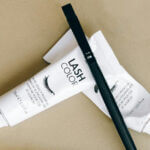
Find the best way to shave your head, plus a step-by-step guide and care tips so that it’s always smooth and shiny.
Wet or Dry?
Like your face, you can shave your head in one of two ways: wet or dry. But is one better than the other? If wet, what kind of razor and lubricant should you use? When can you dry shave? And which finishing products do you need? That all depends on a number of factors, which this post will discuss.
Why Shave Your Head?
I’m a VII on the Norwood scale for male pattern baldness (MPB). With hair remaining only at the sides and back, I’m left with a typical horseshoe pattern. I mostly buzz it once every few weeks for a more mature look, but also like to shave if I want to appear fresher.
But MPB isn’t the only reason for shaving.
With my perfectly rounded head, which baldness seems to suit, I look better without hair than with. That’s why I began shaving long before the MPB set in.
And it has its benefits.
I don’t have to visit the barber, which saves money. I’ve no need for a hairdryer and styling products, which saves space. It shortens my morning routine, saving me time. And my summers are a little cooler.
In spite of this, shaving is not for every man.
If you’re very thin, or have a more challenging head shape, you may want to think twice. But if baldness is not a choice, as in my case, try balancing things out with a beard or mustache. Glasses can also make a world of difference if you select the right frame.
Prominent lumps, bumps, and scars could be another factor in deciding to keep your scalp covered.
The Best Time to Shave Your Head
If you’re shaving your head for the first time, there are two things to consider. One: you’ll be wet shaving, which could irritate your scalp if it’s sensitive. Two: You don’t know what you’ll look like afterwards.
Wet shaving is recommended if you want to remove anything more than stubble. If your hair is longer than a couple of millimeters, an electric shaver probably won’t work, especially not if your hair is thick.
Therefore, plan this somewhat radical move for a quiet Friday evening, and make sure you don’t have to go anywhere until Monday morning. You’ll at least have some stubble back by then, which is less alarming to friends and colleagues than a completely bald head if it turns out to be a mistake.
Even if you’re certain that you’ll look good bald, you should still shave in the evening before going to bed so that your scalp has time to recover from possible sensitivity.
Immediate exposure to blazing sunshine or biting winds would be asking for trouble, and you may be too sensitive for a cap or other head covering.
Personally, I’ve never experienced sensitivity from head shaving, but we’re all different.
Equipment Needed
To shave your head, you’ll need the following items:
- A hand mirror so you can see the back of your head
- Electric clippers to shorten your hair—a beard trimmer will do nicely
- A new, good-quality cartridge razor with at least three blades—never use a dull razor
- A shaving lubricant
- Vegetable or shaving oil (optional)
- Moisturizer
- Good lighting

How to Shave Your Head: A Step-By-Step Guide
Step 1: Reduce Hair Length With Clippers
Using electric clippers without the guard, cut your hair down to stubble, working against the grain—i.e., against the direction of growth. And don’t forget the hairs on the back of your neck.
Your stubble should be no longer than 1/8 inch (approx. 3 mm). The shorter it is, the easier it will be to shave.
Step 2: Shower to “Open Pores” and Soften Stubble
To “open pores” and soften stubble, it’s recommended to take a warm shower. Or, if a shower or steamy bath isn’t possible, place a hot washcloth over your head for a few minutes.
If showering, further soften by shampooing and conditioning; this is of benefit to those with very thick or coarse hair.
I’ve recently started to shower and shave cold, whether it’s my head or beard. I find the result to be smoother. Experienced head shavers could experiment with this.
Step 3: Lubricate Your Scalp
Cover your scalp with a shaving lubricant.
Unless you’re using an old-fashioned safety razor, which I don’t recommend for the head, it doesn’t matter whether you apply shaving soap, foam, or gel.
If you do decide on a safety razor, you’ll have to lather up with a brush and shaving soap. You’ll otherwise cut yourself.
Due to its outstanding lubricating qualities, I pretreat with oil. It makes accidental cutting near impossible and prevents razor bumps and burns. You don’t have to buy a product labeled “shaving oil.” Cooking oil found in the kitchen cupboard will do the same job.
With a generous portion of oil smeared over my head, I then lather up with a brush and shaving soap in order to lift the hair.
Step 4: Shave
Shave with the grain, starting where your hair is at its softest. That means the front first, then the sides, then the back, always working away from the crown. The reason you shave the back last is because the hair there is coarser and takes longer to soften.
Shaving with the grain prevents irritation and ingrown hairs, which can be a problem if your hair is very strong or wavy. Be sure to apply only gentle strokes and minimal pressure. After you’ve shaved once with the grain, you can go over your head a second time against the grain for a closer shave.
Be careful around the ears. Fold them down to avoid cutting.
Keep your head and the razor wet throughout the shave, adding more lubricant as required. Instead of shaving cream, you can apply more oil at this stage. It goes on quickly and is transparent, allowing you to spot missed hairs more easily.
You might also have to change your razor blade before finishing, depending on how strong your hair is.
Take your time, and use a hand mirror so you can see what you’re doing at the back.
Step 5: Check for Stubble
When you think you’re finished, run a hand over your head to check for missed stubble. This can be invisible to the naked eye. Hair in dents and ridges is particularly stubborn, as are cowlicks.
Step 6: Clean Up
When you’re completely stubble-free, rinse your head under a cool or cold shower.
In case you cut yourself, stop the bleeding with a styptic pencil or a piece of tissue placed on the wound.
Step 7: Moisturize
Pat (don’t rub) your head dry with a towel and apply moisturizer. Facial moisturizers designed for men are quickly absorbed and leave a matte finish, if that’s what you want. Preferring the shiny look, I slather on Nivea classic.
Avoid alcohol-based aftershave products, which will do little more than irritate your sensitive, freshly shaved scalp.
If your scalp is very white, a few hours in the open during daylight hours will give it a bit of color, but make sure you don’t burn.
As a newbie head shaver, I went out in the sun with sunscreen on my face but not my head. As a result, I ended up looking as though I was wearing a red skullcap, much to the amusement of friends and colleagues.

Shaving Your Head Daily
If you’re like me, you’ll run your hands over your head several times a day, marveling at its smoothness. Unfortunately, new stubble will surface within about 24 hours, thus spoiling the fun, and your head will lose its shine.
The only thing to do is shave again.
Dry Shaving Your Head
The most comfortable and convenient way of daily shaving is with a dry shaver, which is particularly beneficial for men with a sensitive scalp.
There are shavers available specifically for the head, but I find my foil shaver to be more than adequate. I haven’t yet tried a rotary, but these are said to be even better.
For the smoothest dry shave, sprinkle a little barber powder or cornstarch over your scalp before you begin. This also helps reduce irritation.
Assuming your hair isn’t super fine, you’ll only get thorough results from dry shaving if your stubble is no more than a day or two old. If you’ve left it longer, you’ll have to wet shave.
Wet Shaving Your Head
If you choose to wet shave daily, you’ll soon manage it in a few minutes under the shower without the aid of a mirror—it’s just a question of practice and knowing the geography of your head.
In case your scalp becomes dry and itchy through daily wet shaving, switch to dry.
Caring for Your Shaved Head
Shampoos
There are shampoos available for the bald or shaved head, but these are completely unnecessary. Your usual face and body wash will do the job equally well.
I use superfatted curd soap.
Basically, whatever works for your face will be fine on your scalp.
Moisturizer and Sunscreen
The scalp is particularly prone to dryness and burning, but if you want to show off your shaved head, you don’t want to have to cover it up with a cap.
Use a moisturizer with a built-in sun protection factor to shield your scalp from the sun and harsh weather. There’s no need for a product designed specifically for the head; a facial moisturizer will work just as well.
© 2024 J. Richardson
Related Posts
Disclaimer
The information provided by The Neat and Tidy Man (“we,” “us,” or “our”) on theneatandtidyman.com (the “site”) is for general informational purposes only. While we endeavor to keep the information up to date and correct, we make no representation or warranty of any kind, express or implied, regarding the completeness, accuracy, reliability, suitability, adequacy, validity, or availability of any information on the site. Under no circumstance shall we have any liability to you for any loss or damage of any kind incurred as a result of the use of the site or reliance on any information provided on the site. Your use of the site and your reliance on any information on the site is solely at your own risk.



